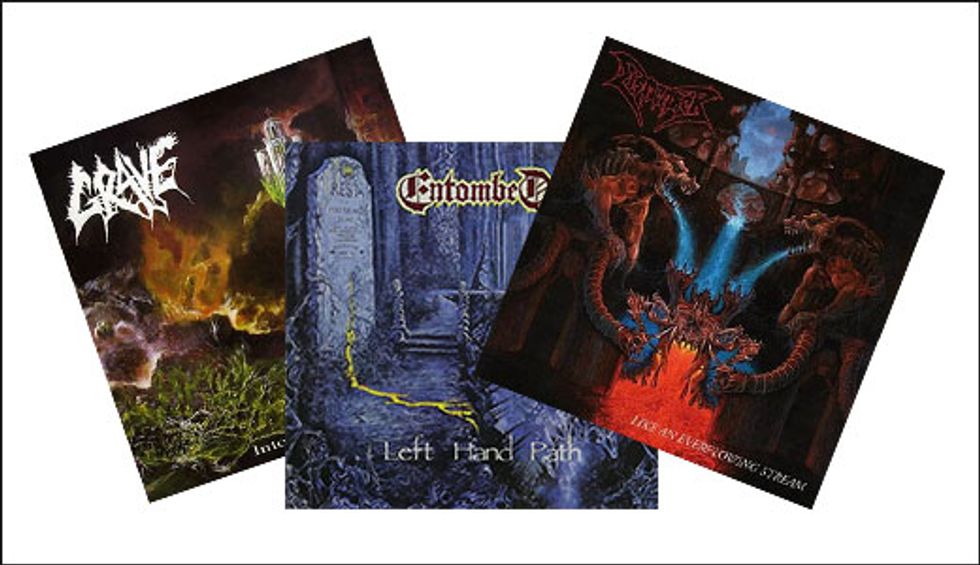Chops: Advanced
Theory: Intermediate
Lesson Overview:
• Understand the intricacies of the old-school death-metal scene.
• Learn how to get the tones of bands like Entombed, Dismember, and Grave.
• Improve your tremolo picking. Click here to download a printable PDF of this lesson's notation.
In this lesson, we’re going back to Sweden for a look at some brutal, old-school death-metal riffs. A while back we explored the Gothenburg style, which is a bit more modern. The metal sounds we’ll discuss this time was forged by bands in and around Stockholm, and occasionally this style has borrowed that name.
These bands emerged a few years before the Gothenburg scene developed and were a massive influence on the melodic death-metal genre. However, being influenced by crust punk and grindcore, these outfits have a raw aggressive sound that is supported by the now legendary “buzzsaw” guitar tone. Often this would include a dimed Boss HM-2 into a clean solid-state amp, but slightly pushed British amps could work well, too. This sound in combination with heavily detuned guitars is absolutely essential to get an authentic Swedish death-metal guitar tone. Most bands tuned down to B standard while some have also used C tuning. The all-star group Bloodbath even go as low as A. After Entombed pioneered this sound with their 1990 album Left Hand Path, such other bands as Dismember, Grave, and Unleashed adopted it and put their own spin on it.
While having a massive influence on the Gothenburg scene in the early ’90s, these bands made a particular impact on contemporary grindcore bands that use the famous HM-2 guitar tone, like Rotten Soundand Nasum, as well as such U.S. metallic hardcore bands as Full of Hell, Trap Them, and Black Breath.
Ex. 1 is reminiscent of Entombed’s first two albums, which originated the style as we know it now. It’s a grooving mid-tempo riff that uses syncopations and power chords from the B half-whole diminished scale (B–C–D–Eb–F–Gb–Ab) that are played against the palm-muted open-6th string. These type of riffs are found all over Left Hand Path and 1991’s Clandestine, after which Entombed turned towards a somewhat more rock-influenced sound, thus creating another subgenre known as death ’n’ roll.
Click here for Ex. 1
Ex. 2 shows this death ’n’ roll approach. It’s a single-note riff based around the B blues scale (B–D–E–F–F#–A) that’s enhanced with a few passing tones to generate more tension. Entombed created the sound of their third album, Wolverine Blues, by combining this type of riff with death metal riffs like the previous one, while maintaining the grinding HM-2 tone.
Click here for Ex. 2
Ex. 3 shows a punk influence and is in the style of Dismember,who tend to mix these d-beat/crust rhythms—alternating eighth- and quarter-notes—with short melodic lines. Harmonically, the riff uses notes from C minor, but adds a b2.
Click here for Ex. 3
The tremolo-picked riff in Ex. 4 is also reminiscent of Dismember and starts out in C minor with an added b5 for extra tension and evilness. During the second half of the riff, I move the same scale shape down to Bb minor while retaining the C on the 6th string. It comes out sounding somewhere between Phrygian and Locrian due to the b5. But don’t think about the theory too much: This riff is based on a visual approach where the scale shape is moved around to where it sounds cool—there really is no theory involved in the writing process.
Click here for Ex. 4
Another approach to tremolo picking pops up in Ex. 5. Here, I pick each note twice, so every pickstroke coincides with a drum hit. This creates a machine gun-like effect during the blast beats, and the technique is often used when the song is too fast to be played in double-time on the guitar. This example demonstrates the “pick twice” approach using the style of the Viking-themed band, Unleashed. The sound I associate most with them is also based on a partially chromatic visual shape that is counterpointed by the open 6th string. The intervals move in minor seconds, tritones, and fourths. The shape shifts in minor thirds before ending in the first position. This sound is found in many old Unleashedsongs.
Click here for Ex. 5
Ex. 6 continues with this sound, but in a slower, more grooving riff. We see the same shape being moved in fourths this time, but it’s a slow melody that’s opposed by syncopated, staccato power chords in the first half of the riff. Such groovy staccato riffs are also typical of Unleashed.
Click here for Ex. 6
Moving on to the last band in today’s lesson, Ex. 7 is a mid-tempo riff in the style of Grave. There are a few different accents that can work along with the drums to give the riff a different feel. Harmonically, we find the same B diminished scale we used before. Another Grave trademark: The riff is played in two different iterations. The first one uses power chords and muted single-notes to create a more syncopated feel, while the other one uses the same notes and note placement within the bar, but features a constant 16th-note line.
Click here for Ex. 7
Grave also tends to change between straight and triplet feels within the same riff. Ex. 8 begins with a fast tremolo-picked section before going into a triplet feel that combines power chords with 16th-note triplets and eighth-notes with eighth-note triplets. This creates very unpredictable and interesting riffs that still follow the same pulse despite mixing different rhythmic feels in the guitar.











![Rig Rundown: Russian Circles’ Mike Sullivan [2025]](https://www.premierguitar.com/media-library/youtube.jpg?id=62303631&width=1245&height=700&quality=70&coordinates=0%2C0%2C0%2C0)



![Rig Rundown: AFI [2025]](https://www.premierguitar.com/media-library/youtube.jpg?id=62064741&width=1245&height=700&quality=70&coordinates=0%2C0%2C0%2C0)











